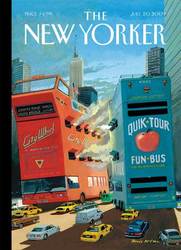Emdashes—Modern Times Between the Lines
The Basics:
About Emdashes | Email us
Ask the Librarians
Best of Emdashes: Hit Parade
A Web Comic: The Wavy Rule
Features & Columns:
Headline Shooter
On the Spot
Looked Into
Sempé Fi: Cover Art
Sempé Fi (On Covers): Trafalgar Square
Filed under: Sempé Fi Tagged: art, Bruce McCall, cars, covers, illustration, New York City, Pollux, The New Yorker

Pollux writes:
Bruce McCall loves cars. This much is clear from the way he depicts his vehicles, glorifying and exaggerating their form. His paintbrushes lovingly depict the details, producing cars that are more detailed than normal for a cartoon or New Yorker cover. McCall is like a miniaturist adding decals to a 1/24 scale 1971 Ford Mustang Pro Street Car.
You don’t need to draw eyes and mouths on cars to give them a personality. McCall loves cars while at the same time lampooning the people who build them. As noted in my last piece on a McCall cover, McCall attacked and lampooned the Detroit auto industry by depicting the cars the city “forgot to build” during the boom years of the 1950s and 60s in his book The Last Dream-o-Rama.
McCall’s new cover offers us a new vision of automobiles gone wild.
For his July 20, 2009 cover for The New Yorker, called “Tour Wars,” McCall depicts an array of cabs, a Porsche, a van, and two towering tourbuses. These tourbuses, engaged in a war of attrition as long as a tea clipper, exchange cannonfire as they drive past one another on their way to competing routes to Grant’s Tomb and 11th Avenue.
There is no contingent of marines or complement of pirates armed with grappling hooks on the decks of these massive earthbound galleons. The tourbuses’ hostility is completely automated and automatic. They fire because they sense an enemy nearby. It makes sense in their brains composed of crankshafts and sumps. One can’t even see the drivers or the tourists on these buses.
And tourists are the key to the castle here. With an ailing American economy, there are fewer tourists and more competition. In McCall’s satirical vision, the competition has become so fierce as to result in Cape St. Vincent-like engagements on the city streets. CityWhirl (“All Manhattan in 6 min.”) versus QuikTour (“101 Sights Per Block”): which of these will be the only company to offer the Hop On, Jump Off experience?
In real life, The Gray Line offers “48 hours of hop-on hop-off double-decker fun that includes the Downtown Loop, Uptown Loop, Brooklyn hop-on, hop off tours and a Night Tour. PLUS, admission to any THREE listed NYC attractions.” A Night Tour from another company claims “best-value double-decker sightseeing packages including major attractions and activities such as harbor cruises, museum visits, helicopter tours, shopping day trips and one-day escorted motorcoach tours to Boston, Washington, D.C. and Philadelphia & Amish Country.”
There is violence in McCall’s image, but it is not a violence of gore and tears. The whiff of grapeshot is evocative of heroic and romantic actions of yesteryear on the high seas rather than the horrors of our current engagements in the Middle East.
McCall’s two lumbering, mutually hostile buses are symbolic of an ailing company that is fighting to gain ground once again and find new strength. And the cars surrounding them, the Porsche, the Rolls, the taxis, and the van, do not flee the scene but remain part of it, inherently supportive of this tour-bus Trafalgar.




